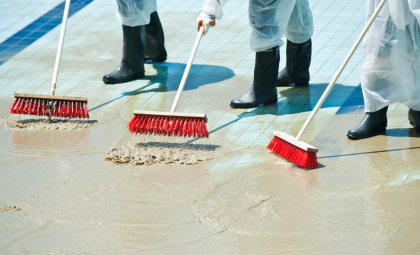Essential Steps for Flood Preparedness and Recovery

Supporting our Subscribers in reducing risk and minimizing loss is key to our mission of building a safer healthcare system. A large part of this effort is collaborating with other insurers to offer Subscribers the most comprehensive and tailored coverage available. Ensuring you and your teams have the right coverage and information for decision-making is a top priority.
The following article is provided by our partners at HSB Canada. Together, we aim to educate HIROC Subscribers on proactive measures and contingency planning, including these essential steps for preparing your organization for a flood.
For any questions or comments, please reach out to us at [email protected].
Flooding, whether caused by severe weather, power interruptions, or equipment failure, can result in significant damage to property and equipment.
In this short video, HSB's Curtis Adumattah, Business Development Representative, and HIROC's Marc Aiello discuss key steps your healthcare organization should take to prepare for and respond to a flood effectively.
Can’t watch this video? Review your cookie preferences by clicking on the banner at the bottom of the screen or the cookie icon on the bottom left of the screen. Watch on YouTube: https://youtu.be/TduytotOTTo (YouTube may prevent signed-out users from accessing videos).
In addition, the following steps are designed to help operations prepare for flooding.
Before the Flood
If flooding is expected, take these steps to minimize damage and speed up recovery:
- Evacuate all personnel before floodwaters rise.
- Move equipment and property to high-ground storage, prioritizing high-value items.
- Construct flood barriers with sandbags or materials if time allows. Even if these do not hold back flood waters, they may resist flood currents sufficiently to prevent destruction of structures.
- Shut down all fuel-burning equipment. In the case of steam boilers, it is best if these can be allowed to cool prior to immersion.
- De-energize all electrical circuits prior to immersion in flood water.
- Move all vehicles to high ground.
After the Water Recedes
The following recommendations are intended to assist in restoring your property and equipment after a flood:
Boilers
- Inspect boiler foundations for settlement. Do not operate a boiler if the foundation is undermined.
- Ensure brickwork, refractory, and insulation materials are thoroughly dry. Use portable heaters if necessary.
- Clean and repair all safety appliances such as safety and relief valves, steam gauge, water column, high and low water cut-outs, and blow down.
- Inspect and test all controls before operation, especially water level and low-water fuel cut-offs.
- Do not fire burners until checked by a technician. An explosion may occur if the combustion controls do not function properly.
- Avoid operating boilers without proper feed water. If operation is essential, and if feed water contains mud, it will be necessary to blow down the boiler every eight hours and to open and clean the boiler at least once per week until proper water quality is re-established.
Electrical Equipment
- Do not energize flooded equipment until it’s cleaned, dried, and insulation is tested, including enclosures, bus ducts, conduit, and cables.
- Windings in electric machinery should not be dried at temperatures exceeding the rating of its insulation system. In general, a maximum temperature of 194 degrees F or 90 degrees C may be used. Check with the manufacturer for recommendations.
- Dry type transformers should be cleaned and thoroughly dried as described for windings.
- Oil filled transformers should be thoroughly inspected for damage and oil samples should be drawn from top and bottom for lab analysis. The laboratory should be instructed to include a Karl Fisher test for water content. If water exceeds 35 ppm, the oil must be replaced by a qualified service firm.
Before Operating Machinery
- Contact the manufacturer for recommendations.
- Inspect foundations for cracking, weakness, or settlement. If settlement is suspected, check and correct alignment of all shafting, and check all stationary components for level.
- Check machine internals for silt accumulations and clean as needed.
- Clear Cylinders of reciprocating engines/compressors of any foreign material or water.
- Drain and Clean Lubrication Systems; use lint-free rags and refill with fresh lubricants.
- Clean and test all governors and controls carefully.
HIROC is here for our Subscribers. If you have questions about coverage, best practices, or would like a quote, please contact HIROC at [email protected].
About HSB Canada
HSB Canada, part of Munich Re, is a multi-line specialty insurer and provider of inspection, risk management and IoT technology services. HSB Canada’s insurance offerings include equipment breakdown, cyber risk and other coverages. HSB blends its engineering expertise, technology and data to craft inventive insurance and service solutions for existing and emerging risks posed by technological change. Throughout its 150-year history HSB’s mission has been to help clients prevent loss, advance sustainable use of energy and build deeper relationships that benefit business, public institutions and consumers. HSB holds A.M. Best Company’s highest financial rating, A++ (Superior).
These recommendations are general guidelines and are not intended to be exhaustive or complete, nor are they designed to replace information or instructions from the manufacturer of your equipment. This article is for informational purposes only and is not intended to convey or constitute legal advice. HSB makes no warranties or representations as to the accuracy or completeness of the content herein. Under no circumstances shall HSB or any party involved in creating or delivering this article be liable to you for any loss or damage that results from the use of the information contained herein. This article does not modify or invalidate any of the provisions, exclusions, terms or conditions of the applicable policy and endorsements. For specific terms and conditions, please refer to the applicable insurance form.